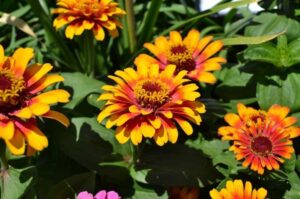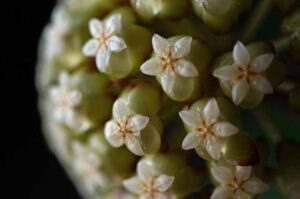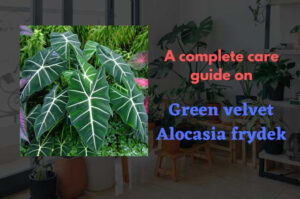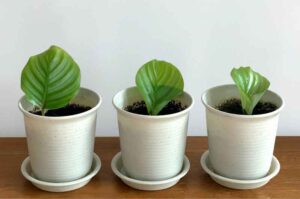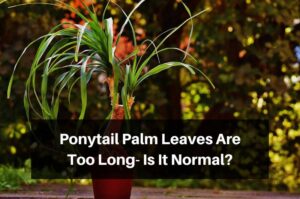Why Are My Caladium Leaves Turning Yellow? (How To Fix It)
Caladiums are beautiful tropical plants famous for their colorful heart-shaped leaves. To achieve optimal growth, this plant needs a precise amount of light, water, humidity, and other factors, the failing of which causes multiple issues like yellowing of leaves, drooping, dying, etc. This article will explain all the probable reasons for which your Caladium leaves are turning yellow.
The most important causes for which the Caladium leaves are turning yellow are overwatering and underwatering. Apart from these issues, other conditions add on to the problem are overexposure to sunlight, low humidity levels, temperature stress, and pest infestation. Natural aging also can turn the Caladium leaves yellow.
The key to reviving a caladium from turning yellow is by understanding the distress and then administering the right cure. And that is precisely what we will be looking at in this article today. Here are a few indicators that might be helpful. Let’s get started with the reasons and remedies without any further ado.
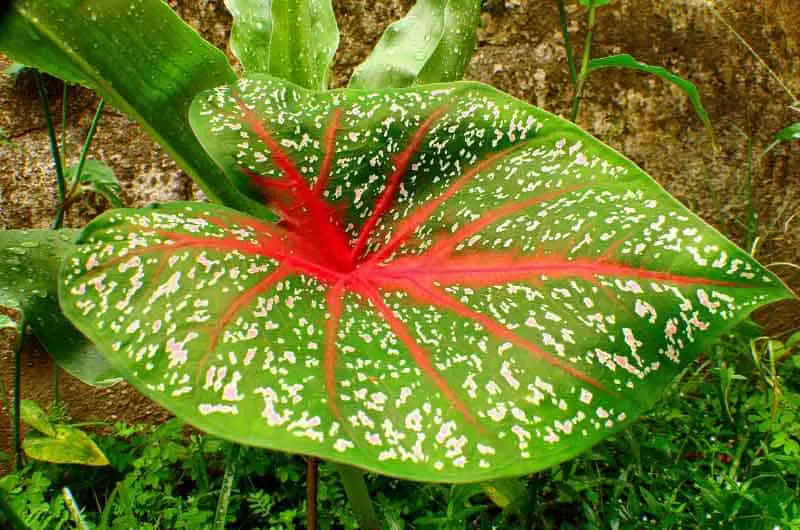
Improper watering habits
It should be appropriate to say that watering is essential for any houseplant’s development. And Caladium is very specific about its water needs. Thus, this is important to understand the need for proper watering for these plants.
In moist soil, Caladium plants thrive the best. The soil should be neither too wet nor too dry.
Very little water in the soil will dehydrate the plant. As a result, your plant will turn yellow due to poor watering practices. Let’s check the two common watering problem-
Overwatering
Overwatering occurs when there is too much water present in the soil. That excess water is not required by the plant. This can cause a variety of unhealthy habits, the most common of which are described below.
Overwatering causes the soil to get congested which leads to obstructing airflow. Because roots need air to survive, this waterlogged condition eventually suffocates them. This can induce root rot as well as open on to fungal diseases. The leaves begin to turn yellow and droop as a result of this.
The most frequent mistake one ends up doing which left the soil soggy are
- The potting soil is not well-drained.
- There aren’t enough drainage holes in the pot.
- You’re putting your plants in a shaded spot with insufficient light.
This causes the soil to stay damp for lengthy periods. Better potting soils should be used to avoid this issue.
How to prevent overwatering in Caladium?
You can take the following measures to prevent the issues related to overwatering.
- Make sure that the pot you’re using has a lot of drainage holes. If your pot has not enough, then get a new pot with a good amount of drainage holes.
- Only water the plants when required. Check the water requirement by dipping your finger into the potting soil.
- Planting should be done in well-drained soil. You can make your potting soil well-drained, by adding some perlite or pumice.
- Use a moisture meter to keep track of how much water you’ve given the plant on a given day.
Only by taking some precautionary measures, you can stop overwatering your Caladium plant, and prevent its leaf yellowing.
Underwatering
The underwatering is the reverse problem of overwatering. When the soil does not receive the minimal amount of water required for the plant’s optimal growth then this occurs. As a result, the foliage begins to lose its allure occurring in the yellowing of your plant’s leaves.
The primary reason behind this is the plant remains in direct sunshine, this causes the water in the soil to evaporate faster than it should.
Another reason contributing to this issue is, watering practices are not regular or the soil used is incapable of holding the appropriate amount of water.
How to prevent underwatering in Caladium plant?
This issue can be easily avoided, by only following some simple steps.
- Try pushing your finger into the potting soil to see whether it’s dry. The soil doesn’t need watering if it feels cold and moist to the touch and you can easily press your finger in an inch or so. However, you should water them if this is not the case.
- Keep the plant out of direct sunlight to avoid excessive water evaporation.
- If the soil is dry, fully water it and allow the surplus water to drain via the drainage system.
- Add some coco peat to your potting soil. It will improve the water-holding capacity of the soil.
- You can also use the self-watering pots and planters, to avoid the issue of overwatering.
You may also like the article- How do self-watering pots work? Complete working principle.
Overexposure to Sunlight
Caladiums prefer to grow in shady places. To grow them better, make sure that, you are planting them in a shadier area of your garden if you are planning to grow them outside.
The main reason for this is that when these plants’ leaves are exposed to direct sunlight, they get sunburned. This makes the plants lose their colors and eventually killing the foliage. Blotches will appear on the leaves if this occurs.
This is an adding problem of the plants becoming yellow.
How to prevent overexposure to sunlight?
These plants don’t have a hard time adapting to the right lighting conditions. The key to prevent overexposure to sunlight is-
- Keep them a few feet away from the windows if you’re growing them indoors.
- Place a sheet or cloth between them and the direct sunshine source.
- Make sure they only get 4 hours of filtered sunshine every day.
Temperature Stress
The temperature is one of the most important deciding elements in Caladium’s growth. These tropical plants turn yellow in the slightest fluctuation of temperature.
To grow properly, the temperature around must be between 65 to 90 degrees Fahrenheit. This generally coincidences with the temperature of your house.
However, this is not sufficient. You may encounter many issues with temperature with these plants. One of them is translucent areas appearing between veins. Short durations of exposure to extreme cold will result in outright browning of the leaf or pale.
To cope with this problem, move your plant to a less turbulent location. If it’s near an air conditioner vent in the summer or a draughty window in the winter move it to some brighter place.
Keep an eye on it to see whether the colorful leaves continue to spread. Misting topicals that you’re overwintering to boost humidity is also a smart idea. To know more about overwintering, check this out: https://youtu.be/cIh-WkJoqRI
Low Humidity Levels
Caladium plants need a high amount of humidity in the surrounding air to thrive. Caladiums require proper light as well as wet surroundings to grow. Thus typical room humidity will not enough. Low humidity also causes the plant to transpire more, which dehydrates it.
The humidity level must be a higher 50% for Caladium to display normal green, healthy leaves. If the humidity level goes below 50%, you’ll see yellow leaves and brown margins on the leaves. And the plant as a whole may begin to droop.
How to increase the humidity levels around the Caladium plant?
To prevent low humidity levels, a couple of precautions can be taken:
- To maintain the higher humidity levels put a humidifier around the plants.
- Growing houseplants in groups is another common approach to boost humidity around them. The moisture content of the air is increased by the mutual action of the plants’ transpiration.
- Introduce a pebble tray to maintain a high level of hydration while reducing the danger of leaf yellowing. To know more on this, click on this link: https://youtu.be/YauDIfDXe9A
- To moisten the leaves hose or spray the plant from time to time. This reduces the dust levels in the leaves. However, spraying a plant or misting is a temporary solution, not a long-term solution.
Improper Potting soil
For a plant to grow healthy, you’ll need to use a suitable potting soil mix with all the necessary features. If the potting soil lacks nutrients and other attributes, your plant is bound to suffer. It loses the capacity to store moisture and drain excess water.
A Caladium plant turns yellow if it does not have enough organic matter in the soil.
The caladium plant’s soil must be a mixture of damp soil and peat. Apart from this, we have to keep in mind the soil has rich organic matter and a good drainage system.
You can make your potting soil at home, by following this article, or buy good potting soil online.
Caladiums like somewhat acidic soil with a pH of 5.5 to 6.5. You may verify if the pH of the soil is balanced or not by utilizing a litmus test strip or a soil pH tester. How to use pH strip for soil: https://youtu.be/xIz2YPBXuZU.
Improper Use of Fertilizers
The proper balance of fertilizers helps Caladium plants to grow properly. These should be used with caution and in specific amounts and concentrations. This is because applying too little fertilizer will lead to the plant, not receiving adequate nutrients. Whilst applying too much fertilizer can produce difficulties.
Excess fertilizers accumulate as salts in the soil. This reduces the plant’s capacity to absorb water. As a result, both of these factors might cause your plants to yellow.
The necessary solution to this is to use water-soluble fertilizers every 3-4 weeks. Another excellent idea is to choose organic alternatives. The main purpose of this to have healthy plants. This delivers adequate nitrogen and phosphate to the plant.
Pest and Diseases
Caladium plants are rarely bothered by insects. Yet, caladium plant pests do occasionally nibble on their leaves or cell sap.
Aphids and caterpillars can be an issue. Some others can trouble your Caladium. Such as mealybugs, aphids, spider mites, scale, and thrips.
Vigilance is your best protection against caladium plant pests. Look for the animals and handpick them off the plants when you notice ragged borders on the leaves. If the infestation gets out of hand, you can use any organic insecticide available in the market to control them.
Aphids can be a nuisance, but they normally do not represent serious harm to plants. Wash them away with the hose or, if required, manage them with horticultural soap or neem oil.
Caladium plants are made up of tubers, and the illnesses that affect them are tuber diseases. Typically, fungal infections such as Rhizoctonia and Pythium species cause these illnesses. These are sometimes seen in dormant tubers.
If you want to start preventing caladium fungal issues, soak the tubers in hot water. The water should be at least 122 degrees Fahrenheit before planting or storing them. To destroy hazardous fungi, leave them in for 30 minutes. Make sure the tubers are completely dry before using them.
Natural Aging
As many plants age, Caladium also ages naturally. As they grow older, the leaves will turn yellow and fall off. This is just a natural aspect of their development. This is more or less out of your hand. But you can protect your caladium in a way till the next spring by storing the tubers. Though this is not that effective you can always give it a try.
Nutrition deficiency
Plant leaves can also become yellow if they don’t get all the nutrients they need. This can be caused by a nitrogen deficit or too much calcium in the water if you use hard water. Caladium leaves may turn yellow because of the absence of Manganese or Zinc. Caladium also requires iron and nitrogen.
To avoid this problem, you might use a balanced liquid fertilizer or ready-to-use all-purpose balanced fertilizer.
Can yellow leaves turn green again?
Yes, the yellow leaves can regain their colors again, provided they are not mature and old. If the leaves have turned yellow due to some physiological stress like overwatering or underwatering, or temperature stress, etc. they can again turn green when an ideal condition is provided to them.
If the leaves have turned yellow as a process of natural aging, they will never turn green again. They will turn yellow and dry up and then gradually die.
Can Removing Yellow leaves help?
Yes, indeed. Remove yellow and brown leaves as quickly as possible from your caladiums. Cut them only if they’re more than 50% damaged. Yellow leaves should be removed to avoid the yellowing of other leaves. It sometimes becomes immense necessary as the remaining healthy foliage receives more nutrition.
By removing these yellow leaves, the beauty of the plant improves, and the nutrient efficiency will increase.

